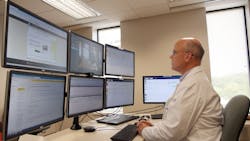It is widely known that long emergency room wait times are a persistent challenge for hospitals and health systems across the country. The median wait time from the point of arrival in the emergency room to the time a patient sees a medical professional, or what’s called door-to-doctor, is about 30 minutes, according to 2014 data from the Centers for Medicare & Medicaid Services (CMS). However, the CMS data tracks average wait times by state and the times vary from 46 minutes in Maryland to 16 minutes in Colorado. Data from the U.S. Centers for Disease Control and Prevention (CDC) published in 2014 indicates that the median treatment time was more than 90 minutes. The CDC data also indicated that 41 percent of patients waited 15 to 59 minutes, 27 percent waited fewer than 15 minutes and 13 percent waited one hour but less than two hours.
Data from ProPublica’s ER Wait Watcher site, which uses Google data, estimates the national average ER wait time as 24 minutes, but the site also estimates the average time, nationwide, that patients spent in the ER before being sent home is 135 minutes, or two hours and 15 minutes. With patient volume in emergency departments expected to increase in the next five years as sicker, more complex patients drive up ED care, it is anticipated this challenge of long ER wait times will only grow.
Physician leaders at Milwaukee, Wis.-based Aurora Health Care are familiar with this challenge and this past year the health system deployed a telemedicine solution with the aim of improving patient flow in its emergency rooms with the overall goal of enhancing patient care and providing a better patient experience. The ED technology solution, a tele-triage approach, was deployed first at Aurora Sinai Medical Center last December and the health system recently expanded the technology to Aurora West Allis Medical Center and Aurora Medical Center in Kenosha.
Aurora Health Care is a health system with 15 hospitals and 159 clinics serving areas of eastern Wisconsin and northern Illinois. Aurora Sinai Medical Center is a 177-bed general medicine and surgical hospital located in downtown Milwaukee, and like many other urban emergency departments, the hospital has seen a steady increase in ED volumes, according to Paul Coogan, M.D., president of Aurora Emergency Services and an emergency department physician at Aurora Sinai.
“We now see over 60,000 patients a year, and just a couple years ago, we were under 50,000 patients a year. So we were seeing a gradual increase in our door-to-provider times, and our overall length of stay, so we needed to come up with a solution to help address our increased demand,” he says.
Paul Coogan, M.D.
Coogan continues,” For a period of time, as they’ve done in other ERs, we put a provider out in triage and had that person interact with the patients in triage, and that was pretty well received. But the problem was, you can only cover one site, and that person was putting in orders, but the idea that we could cover multiple sites through a telemedicine product was exciting.”
Michael Rodgers, director of strategic innovations for Aurora Health Care, says implementing a triage approach in the emergency room served as a springboard for the development of the technology initiative.
“We didn’t start thinking that this was the solution that we would end up with. We started with a provider on triage and we’re getting a lot of benefit from that. We actually just thought, ‘how can we actually replicate that?’” Rodgers says.
Aurora Health Care leaders saw an opportunity to work with a local health IT startup company, EmOpti, Inc., based in Brookfield, Wis., on a technology solution that would replicate the triage approach.
“So we used a Lean startup methodology, just like a startup company would use, to quickly figure out what would work the best and we’re continuing on that path as we go forward, with features, functionalities and a road map that we have set up to even take this initiative to the next level,” Rodgers says. “At the end of the day, this is actually what we came up with. Telehealth wasn’t the goal; it was more the outcome to solve a problem, and the opportunity to enhance the care to our patients.”
Michael Rodgers
And, he adds, “One reason we went with this solution is that, to be honest, we didn’t find anything else out there. I know other healthcare systems are starting to dabble in this area, but there’s not a solution out there that we found that could really help with tele-triage and that would really help to build out a system that would enable us to expand beyond just one site, and really make it effective in multiple different areas.”
EmOpti was founded by Edward Barthell, M.D., an emergency physician, and the company develops acute care optimization solutions that utilize command center, analytics and telemedicine technology to enable physicians in support centers to securely interact with multiple acute care facilities simultaneously.
The tele-triage technology solution allows patients who seek care at an emergency department at Aurora Sinai, Aurora West Allis or Aurora in Kenosha to be seen by an Aurora physician via video when they arrive, with another caregiver right at the patient's side. The offsite physician can serve multiple Aurora emergency departments at once.
“This solution helps us get orders started immediately, obtain results quicker and treat people faster— ultimately, it helps us provide an enhanced patient experience to all who visit the ED. That is critically important for an ED that is as busy as the one at Aurora Sinai,” Coogan says.
According to Coogan, the provider in triage is stationed in a separate support center, “what we refer to as ‘the bunker,’” he says. “It’s a actually a nice room with multiple screens and when the patient presents to one of our three hospitals, to triage, the nurse gets a brief history, does vital signs, and then the nurse requests a consult. And I’ll get a ping, and I can click on that and open up the files, which opens up the patient’s chart so I’m face-to-face with the patient. The average consult is lasting about a minute and 20 seconds.”
Coogan points out that ER physicians are experienced at developing quick rapport with patients. “They don’t know us and so it’s a natural fit for us to be able to establish rapport, and even though it’s a minute and 20 seconds, we’re able to get the necessary information from the patient,” he says. “Then we’ll sign off with the patient and I’ll explain to him or her, ‘now we’re going to get some testing started on you to help speed up this process.’ At that point, one of our technicians will be there in triage to draw their blood, maybe get an EKG, and our radiology department is notified of any X-rays that we order. The plan is that by the time they get back to the room, that most of their workup is already done.”
Since deploying the tele-triage solution at Aurora Sinai Medical Center, the results and outcomes, so far, have been significant.
“I think one of the biggest things is that we’ve had the opportunity to do is that we’ve been able to reduce our door-to-doctor times by 75 percent. We’ve been able to effectively use that same model across multiple hospitals, which is huge, to provide a benefit for even more patients,” Rodgers says. “The other aspect of that is that length of stay is reduced and our left without being seen (LWBS) rate is reduced as well. And that all goes back to enabling patients to be able to see a doctor quickly, get their orders entered and make sure the patients understand that they are our top priority with getting them treated well.”
According to Rodgers, patient satisfaction, based on survey scores, increased following the technology implementation and anecdotal feedback from doctors and nurses supports the idea that the services are well-received by patients.
Furthermore, Coogan believes improving the patient flow in the ER is not only a patient experience issue, but a quality of care issue as well. “The biggest complaint we face nationally in the ER is overall wait time, so if you can address that, the patient experience scores are going to improve, which is what we saw. And, also just for quality, the faster you can see patients and get their orders in and take care of any abnormal results, not only does it decrease overall length of stay, it’s just an overall patient safety measure. Studies have shown that the longer the patients’ length of stay, the more boarding you do of patients in the ER, the more hospitals are on ambulance diversion, all those things lead to increased patient morbidity and mortality. So, anything you can do to speed your disposition of patients improves not just the patient experience but, more importantly, morbidity and mortality.”
Rodgers also points that hospital reporting measures as required by the Centers for Medicare & Medicaid Services (CMS) includes ER metrics. “This was also a big motivator to spend more resources addressing ED length of stay,” he says.
Initially, hospital leadership anticipated older patients would be hesitant to utilize the tele-triage services. “We thought, ‘well, this is going to be an issue, they are going to think it’s too impersonal.’ But what’s interesting is that our older patients really have been the most satisfied. It’s surprising to us. I think they just enjoy the technology,” Coogan says, also noting that of the tens of thousands of consults that have occurred in the past year, “only a couple of people have declined” the tele-triage services.
“The patients have really enjoyed this, and they really like the fact that they get to talk to a physician right away,” he says.
As part of the technical implementation of the health IT solution, EmOpti worked with another vendor to integrate the technology with the hospital’s Epic electronic health record (EHR) system. “We actually integrated with Epic, so we use Epic and EmOpti together and they are in sync. So it’s not something where it’s built in. I equate it to almost like a Legos set, where you have different pieces that you put together and it naturally fits. It seems to work that way very well then, internally, we have an interface team that’s done an outstanding job with this,” Rodgers says.
While there was some initial resistance from physicians, nurses and staff to using a new, additional technology tool, but ER staff, nurses, technicians and physicians have embraced it, Coogan says. “As long as it’s presented as ‘this is something we’re using to not only improve the patient experience, but it really will improve your work life.’ What we found is that some of the downstream effects are that nightshifts are less busy because you’re not walking into an ED at 11 p.m. with 20 patients waiting to be seen and nothing having been done on them.”
Additionally, older physicians are showing an interest in the possibility that tele-triage shifts, as opposed to physical shifts in the ER, could prolong their careers, Coogan says. He adds, “The nurses like it because being a triage nurse is a pretty lonely job, you’re out there on your own, you have to make all the decisions. They have to decide, ‘Is this 35-year old person with chest pain, is it safe to put them in the waiting room, or do I need to rush them back?’ So by getting a consult, I can talk to the patient, look at their EKG right over the telemedicine, and I can say, ‘let’s just move that person to the back,’ or ‘that EKG looks fine, I think we can get blood work started but until a bed becomes available, that person is fine to wait in the waiting room.’”
Coogan and Rodgers add that executive leadership at the health system increasingly supports the use of technologies, such as the tele-triage solution, to enhance patient care. In addition to the three hospitals previously mentioned, the health system has expanded the use of the tele-triage services to a handful of urgent care clinics.




